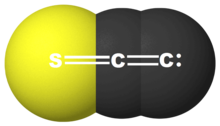Thioxoethenylidene, is a reactive heteroallene molecule with formula CCS.[1]

| |
| Names | |
|---|---|
| IUPAC name
Thioxoethenylidene
| |
| Identifiers | |
3D model (JSmol)
|
|
| ChemSpider | |
PubChem CID
|
|
CompTox Dashboard (EPA)
|
|
| |
| |
| Properties | |
| C2S | |
| Molar mass | 56.08 g·mol−1 |
| Related compounds | |
Related compounds
|
CS SCCS SCCCS |
Except where otherwise noted, data are given for materials in their standard state (at 25 °C [77 °F], 100 kPa).
| |
Occurrence
editCCS is found in space in large quantities.[1] This includes the Taurus Molecular Cloud in TMC-1, TMC-1c and L1521B. These are likely in young starless molecular cloud cores.[2]
Production
editBy condensing propadienedithione SCCCS or thioxopropadienone OCCCS in solid argon and irradiating with ultraviolet radiation, CCS is formed.[1] Another way is via a glow discharge in a mixture of carbon disulfide and helium. Yet another way is through electron irradiation of sulfur containing heterocycles.[1]
CCS and the anion CCS− can be formed in solid neon matrices also.[3]
Properties
editCCS can be a ligand. It can form an asymmetrical bridge between two molybdenum atoms in Mo2(μ,σ(C):η2(C′S)-CCS)(CO)4(hydrotris(3,5-dimethylpyrazol-1-yl)borate)2 In this one carbon atom has a triple bond to a molybdenum and the other has a double bond to the other molybdenum atom, which also has a single bond to the sulfur atom.[4]
The ultraviolet spectrum shows absorption bands between 2800 and 3370 Å and also in the near infrared between 7500 and 10000 Å.[1] CCS can react with CCCS to form C5S.[1]
The infrared spectrum in solid argon shows a vibration band at 1666.6 cm−1 called v1 and another called v2 at 862.7 cm−1. The 2v1 overtone is at 3311.1 cm−1. A combination vibration and bending band is at 2763.4 cm−1[1]
The microwave spectrum has emission lines 43 − 32 at 45.4 GHz and 21 - 10 at 22.3 GHz, important for detection of molecules in molecular clouds.[2]
Theoretical predictions show that the C-C bond is 1.304 Å long and the C–S bond is 1.550 Å.[5]
References
edit- ^ a b c d e f g Maier, Günther; Reisenauer, Hans Peter; Ruppel, Raimund (October 2004). "Thioxoethenylidene C2S: A Matrix-Spectroscopic Study". European Journal of Organic Chemistry. 2004 (20): 4197–4202. doi:10.1002/ejoc.200400252.
- ^ a b Roy, Nirupam; Datta, Abhirup; Momjian, Emmanuel; Sarma, Anuj P. (20 September 2011). "Imaging of the CCS 22.3 GHz emission in the Taurus Molecular Cloud complex". The Astrophysical Journal. 739 (1): L4. arXiv:1106.4011. Bibcode:2011ApJ...739L...4R. doi:10.1088/2041-8205/739/1/L4. S2CID 118857505.
- ^ Riaplov, Evgueni; Wyss, Muriel; Maier, John P; Panten, Dietmar; Chambaud, Gilberte; Rosmus, Pavel; Fabian, Juergen (November 2003). "Electronic absorption spectra of CCS− and CCS in neon matrices". Journal of Molecular Spectroscopy. 222 (1): 15–21. Bibcode:2003JMoSp.222...15R. doi:10.1016/S0022-2852(02)00050-4.
- ^ Caldwell, Lorraine M.; Hill, Anthony F.; Stranger, Robert; Terrett, Richard N. L.; von Nessi, Kassetra M.; Ward, Jas S.; Willis, Anthony C. (12 January 2015). "Thioxoethenylidene (CCS) as a Bridging Ligand". Organometallics. 34 (1): 328–334. doi:10.1021/om5011319. hdl:1885/13701.
- ^ Xie, Yaoming; Schaefer, Henry F. (March 1992). "Naked organosulfur clusters: The infrared spectrum of the C2S molecule". The Journal of Chemical Physics. 96 (5): 3714–3717. Bibcode:1992JChPh..96.3714X. doi:10.1063/1.461874.